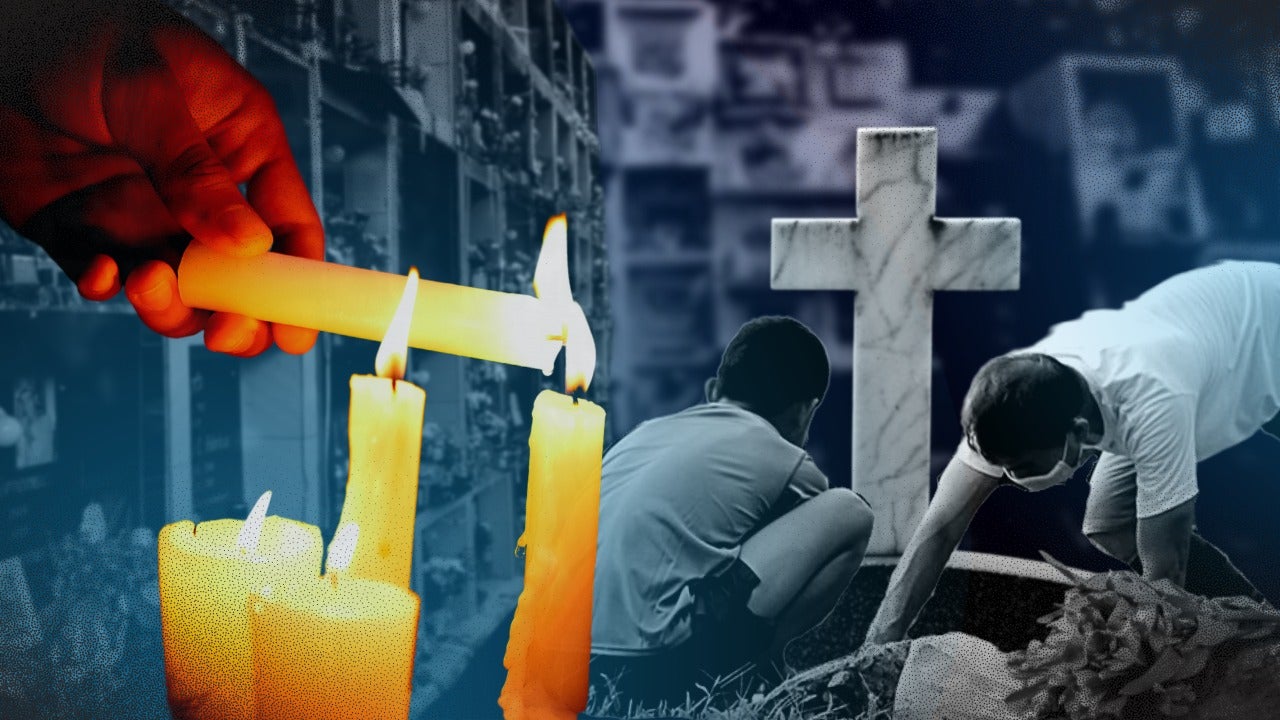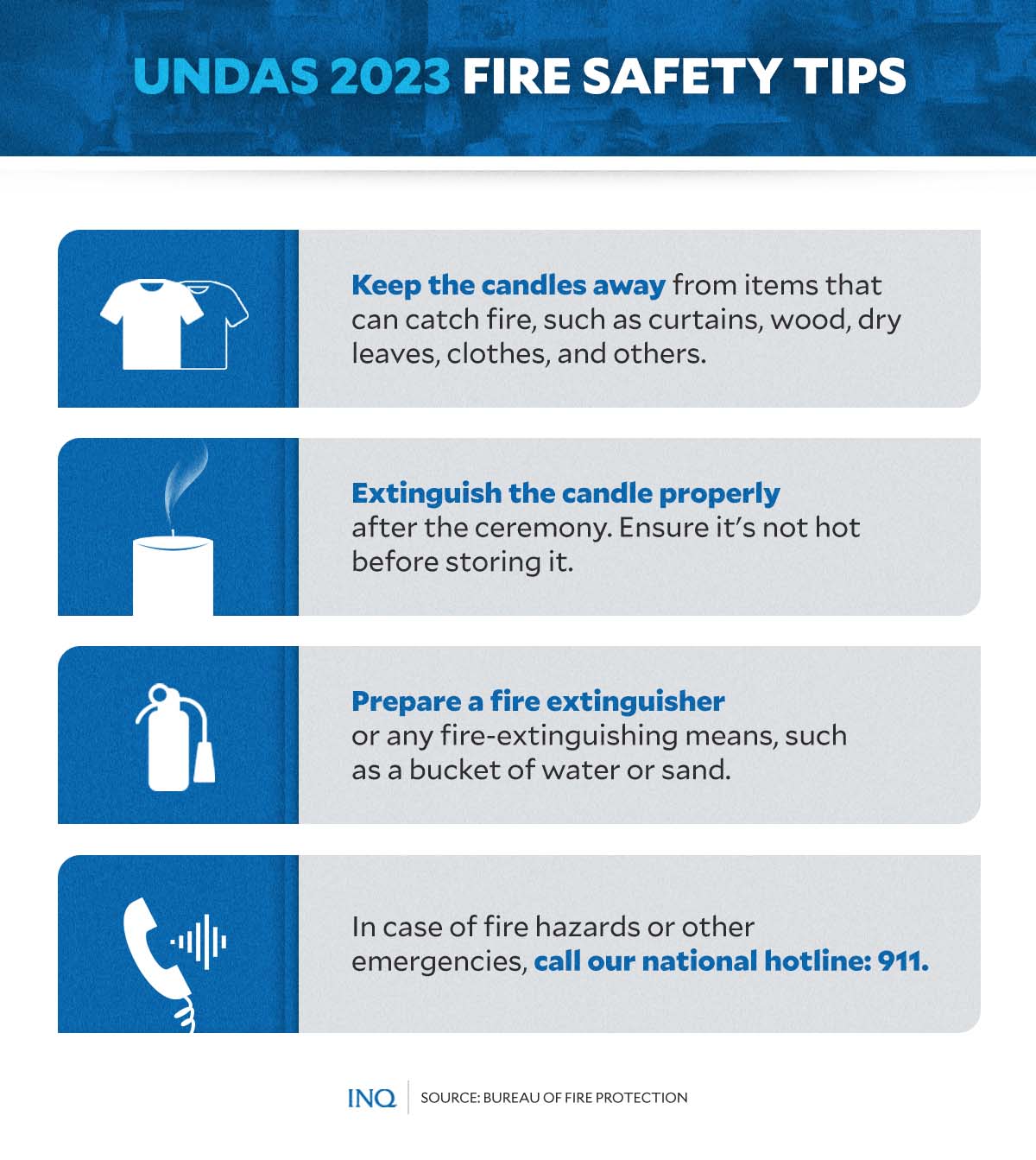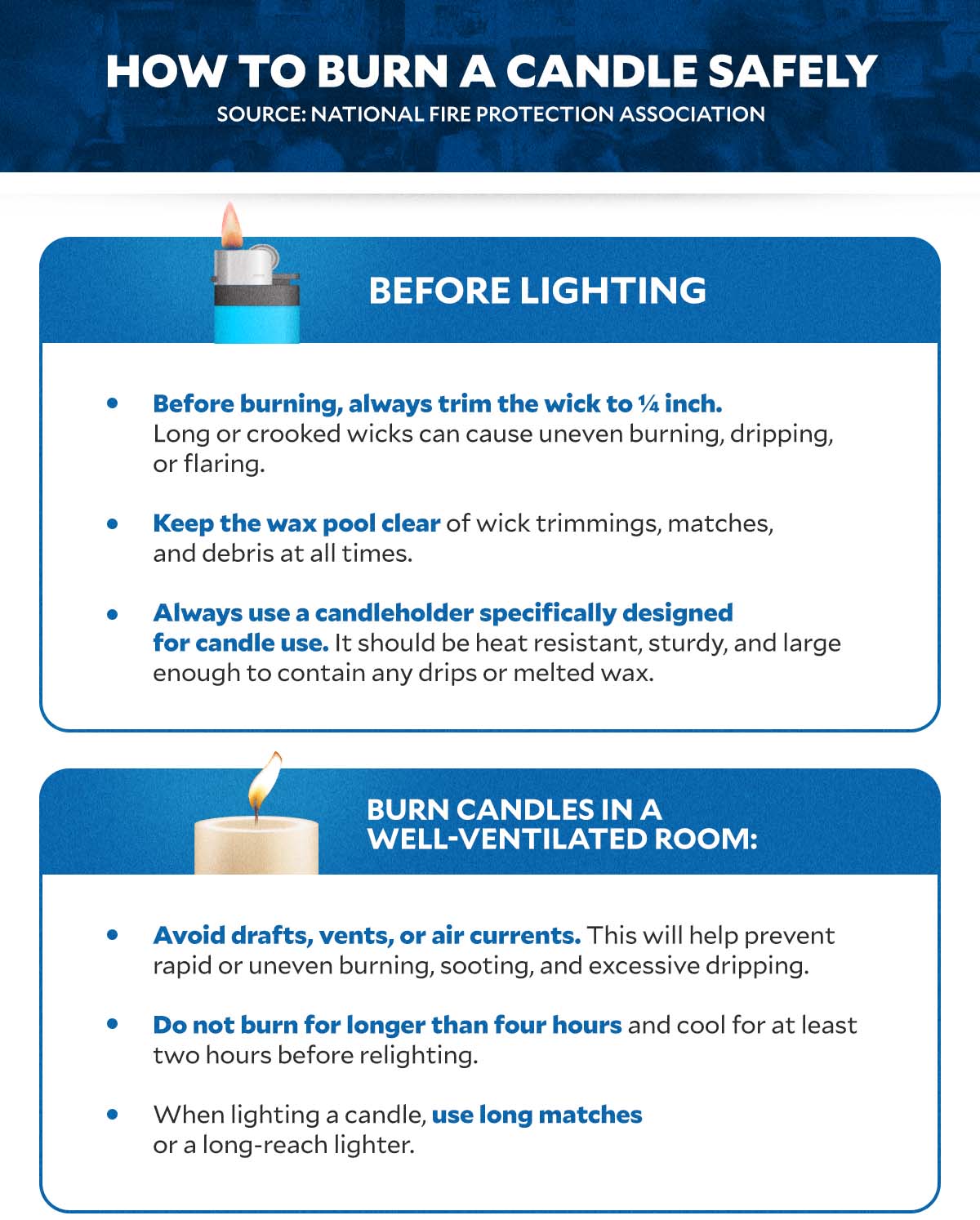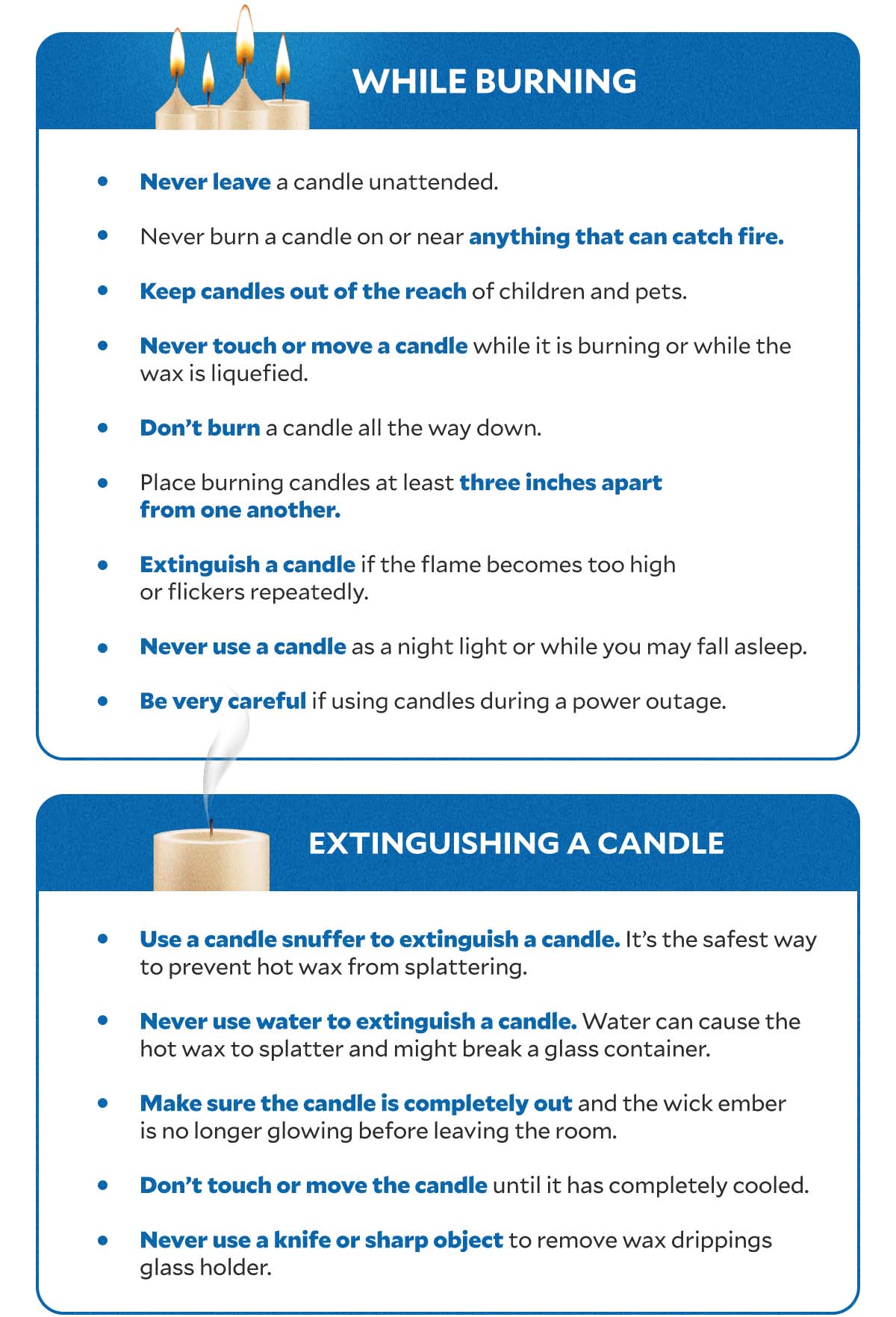Undas practices continue at home for those absent in cemeteries, columbaria
MANILA, Philippines—While visiting cemeteries and columbaria during All Souls’ Day, or every 2nd of November, has been a permanent fixture of Undas tradition among many Filipinos, some choose to honor their deceased relatives by lighting candles and placing these outside their homes instead.
Families gathering in mausoleums, people lighting candles and leaving flowers on cement graves, and rows of vendors selling candles and flowers. These are the usual scenes every Undas in the Philippines.
READ: Keeping Filipinos’ Undas traditions alive
However, for some — including those who cannot visit cemeteries and columbaria — the traditions are carried out even in the comfort of their homes.
In such instances, one way Filipinos remember their departed loved ones is by lighting candles outside their homes, typically near their doorsteps or gates, and leaving those burning for the rest of the night.
A religious tradition
During Undas, many light up candles as a form of offering or sacrificial gift for departed loved ones. Most Filipinos likewise believe candles should be lit not only for relatives and friends who died but also for lost souls who seek to be remembered every Undas.
In a predominantly Catholic country, such as the Philippines, candles are usually lit for prayer intentions. The act of lighting a candle, most devout Catholics believe, helps drive away any evil spirit.
READ: All Souls’ Day: Why do we pray for the dead?
“Personally, I believe that by lighting candles during Undas, we remember and honor the souls of our departed loved ones. Additionally, this is our way to pay respects and pray for the souls of our loved ones,” explained Nelle Gaboy in an interview with INQUIRER.net.
According to Gaboy, lighting candles during prayer is considered a symbolic and reverent practice among Catholic devotees.
“Whether during personal prayers, religious services, or visits to a church, the act of lighting a candle goes beyond expressing and acknowledging Christ as the Light of the World. It is also a way to seek guidance and offer supplications,” she added.
For Helen Yap, the long-standing Filipino tradition helps guide the souls of those who have died as they embark on their journey to the afterlife.
“We light a candle near our door every Nov. 2 because we believe that the light of the candle will help souls to see their path, for them to go to Heaven. That is the oldest reason I know, which I heard from elders when I was young,” Yap told INQUIRER.net.
While this Undas practice has been long associated with religious beliefs, both Gaboy and Yap said it has also become part of Filipino culture.
Fire and safety risks
However, the yearly tradition of lighting candles for the souls of the deceased also comes with safety risks.
In the past years, several fires during Undas — or from Oct. 31 to Nov. 2 — caused by unattended lighted candles have been reported, which often caused deaths and left many people homeless.
Data from the Fire Arson Investigation Division (FAID), Directorate for Intelligence and Investigation (DII) of the Bureau of Fire Protection (BFP) showed that from 2018 to 2022, a total of 447 fire incidents transpired during Undas across different parts of the country.
The highest number of Undas-related fire incidents was 125 in 2018, 34 of which occurred in the National Capital Region (NCR).
Last year, there were only five fire incidents recorded during the Undas holiday. These incidents occurred in Western Visayas and MIMAROPA (Mindoro, Marinduque, Romblon, and Palawan).
According to BFP, the top causes of fire incidents during Undas were:
- Open flame: 161 (open flame from an unattended lighted candle: 97)
- Electrical: 116 (electrical ignition due to loose connection: 59)
Other possible causes of fire during the said period include lighted matchsticks or lighters, open flames from kerosene lamps, and overheated home appliances.
Every Undas, the BFP reminds the public to observe fire safety, especially when leaving lighted candles outside homes.
Preventing candle-related fires
Back then, Yap recalled, people were usually advised to leave burning candles outside their homes overnight, especially in rural areas or provinces. However, fires have made people more cautious when practicing this Undas tradition.
“[N]ow, as I observed, when people would go to sleep, they make sure that there are no lighted candles [outside their homes]. People are cautious [that leaving lighted candles] might cause a fire,” Yap said.
“For us, we light a candle before six in the evening and put it off before we sleep,” she said, adding that they usually leave the candles burning for at least four hours.
Gaboy likewise said she and her family always make sure that they apply precautionary measures when lighting candles outdoors for All Souls’ Day.
“[W]e ensure that candles placed in stable holders are not left unattended while still burning,” she said, explaining that they don’t usually have a specific time set for leaving lighted candles unattended.
“This precaution is crucial, especially since we reside in a compound residential area,” she continued.
According to BFP, the public can avoid or prevent candle-related fires during Undas by adhering to these safety precautions:
- Keep candles away from items that can catch fire, such as curtains, wood, dry leaves, clothes, and others.
- Extinguish the candle properly after the ceremony. Ensure it’s not hot before storing it.
- Prepare a fire extinguisher or any fire-extinguishing material, such as a bucket of water or sand.
In case of fires or other emergencies, BFP strongly advised the public to call 911 — the national emergency hotline.
Burn candle safely
In the United States, the National Candle Association (NCA) and the National Fire Protection Association (NFPA) have issued general guidelines on how to burn a candle safely.
These include trimming the wick of the candle to 1/4 inch and removing any debris left in the wax pool, such as wick trimmings or discarded matches, before lighting a candle.
“Any debris will add more fuel to the candle than it’s designed to handle. Too much fuel can cause the flame to unexpectedly flare up or even start a small fire near the candle flame,” the guidelines read.
“Wicks that are left long or crooked can cause uneven burning, dripping, flaring, and sooting,” it added.
The NCA also noted that candles should not be left burning longer than the recommended duration indicated in the manufacturer’s instructions.
“Burning a candle for too long will cause carbon to collect on the wick, leading it to “mushroom.” The wick will then become unstable and produce a dangerously large flame,” it explained.
“In general, it is recommended that candles do not burn for longer than four hours and cool for at least two hours before relighting,” the NCA added.
A study by the US Consumer Product Safety Commission suggested that 85 percent of candle fires could be avoided if consumers followed three basic safety rules:
- Never leave a burning candle unattended.
- Never burn a candle on or near anything that might catch fire.
- Keep candles out of the reach of children and pets.




